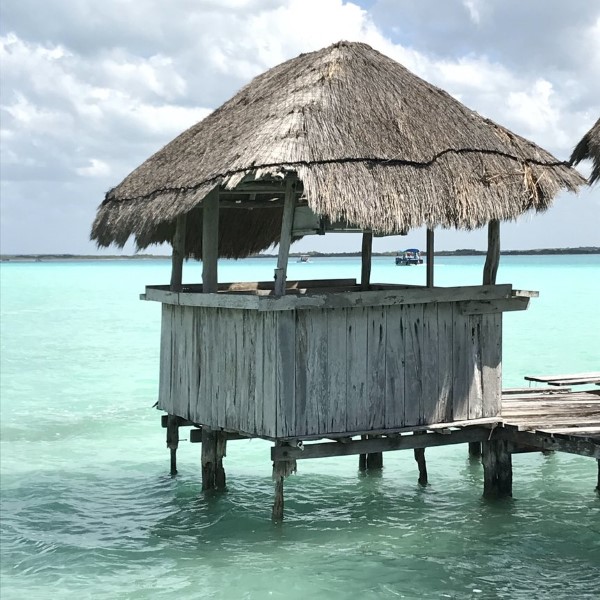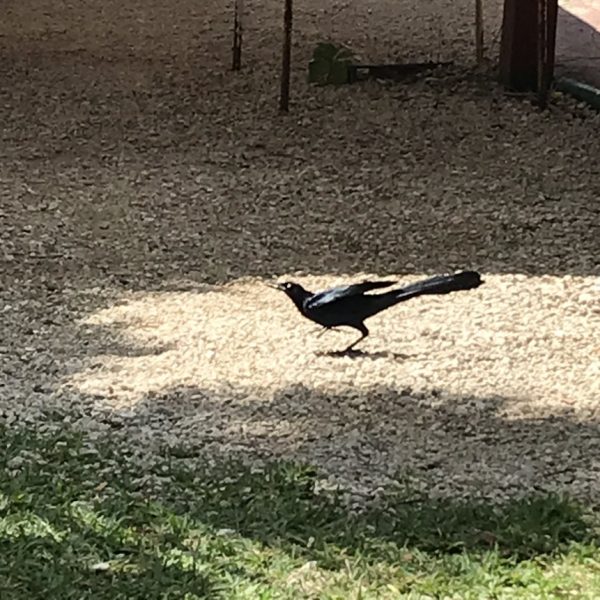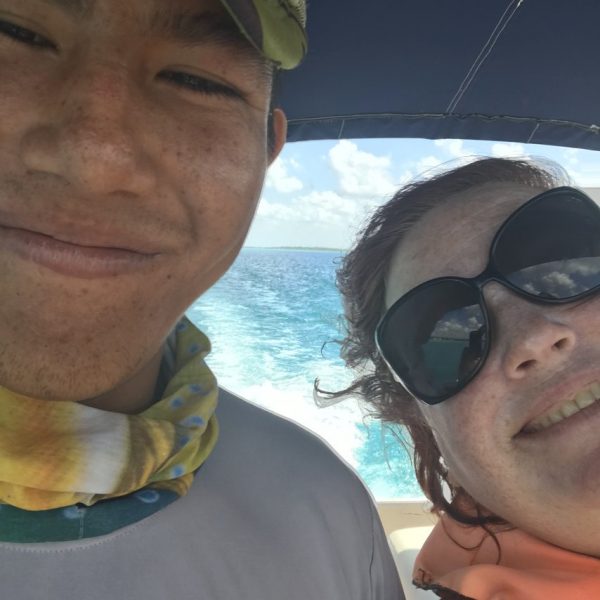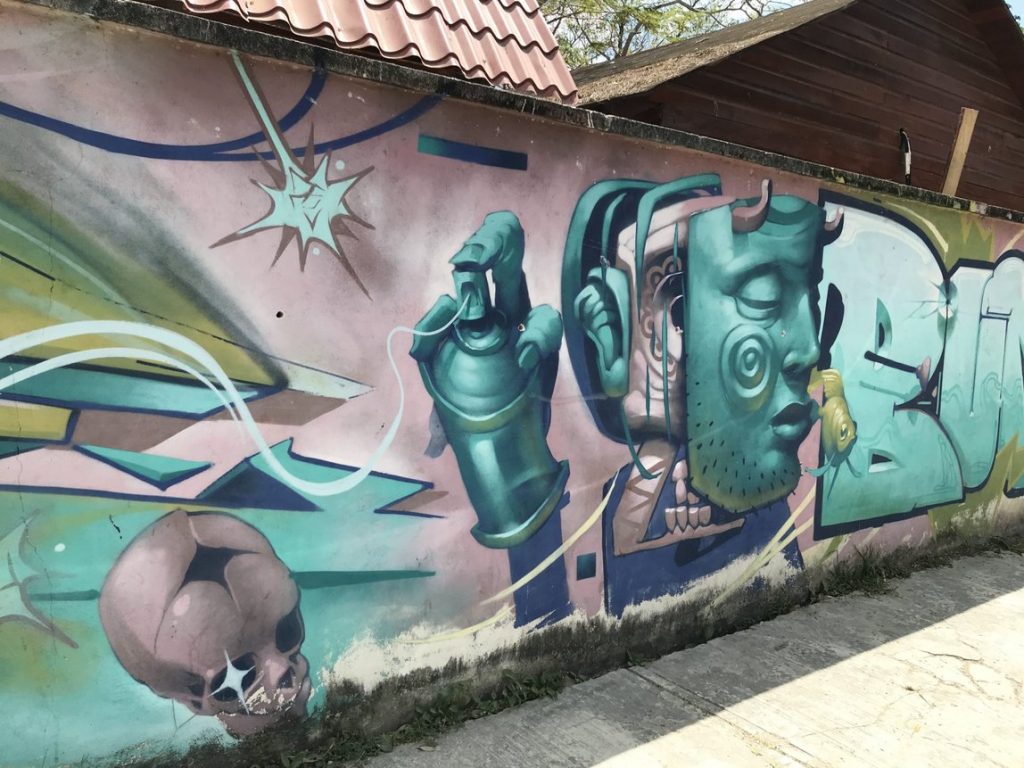 Fed by an underground cenote, this lagoon’s waterways seperate into seven or more shades of blue. Although called the Lake of Seven Colors, with a sandy bottom and warm water for swimming, it is a series of passages that lead to the sea. I took a shore excursion that included a boat ride and lunch in a little resort area.
Fed by an underground cenote, this lagoon’s waterways seperate into seven or more shades of blue. Although called the Lake of Seven Colors, with a sandy bottom and warm water for swimming, it is a series of passages that lead to the sea. I took a shore excursion that included a boat ride and lunch in a little resort area.
This is our boat captain. He asked me what kind of music I liked. After some discussion, he put on reggae, which was the perfect music for living my best life on the water.
The lagoon had many shades of blue, and you can see them in these pictures, especially the ones with a clear delineation. These photos are from inky indigo to pale turquoise.
When we got to an area of shallow, clear water, we took a break for a swim. The only other people on the boat were an Italian couple. Although we had a language barrier, we got on like a house on fire.




 Afterwards we had a nice lunch of fajitas. Later they brought out fried fish, like fish n chips that was some of the best fish I’ve ever had.
Afterwards we had a nice lunch of fajitas. Later they brought out fried fish, like fish n chips that was some of the best fish I’ve ever had.
I don’t know what kind of birds these are. They are cool.

 Although we didn’t visit it, the town is home to The Fuerte de San Felipe, a fort built to fight pirates, that is now a museum dedicated to the history of piracy. After lunch I wandered around the little town.
Although we didn’t visit it, the town is home to The Fuerte de San Felipe, a fort built to fight pirates, that is now a museum dedicated to the history of piracy. After lunch I wandered around the little town.
 All of the cruise ports have entertainment and little shops and restaurants. The port had interesting performers for photo ops.
All of the cruise ports have entertainment and little shops and restaurants. The port had interesting performers for photo ops.
 When I was a kid, we saw the Danza de Volares, Dance of the Fliers, on a TV show called “Thrill Seekers.” I had not really thought about it since. I was so shocked and delighted to see them in person in the cruise port, I stopped dead in my tracks and uttered an expletive.
When I was a kid, we saw the Danza de Volares, Dance of the Fliers, on a TV show called “Thrill Seekers.” I had not really thought about it since. I was so shocked and delighted to see them in person in the cruise port, I stopped dead in my tracks and uttered an expletive.
FROM WIKI:
“The Danza de los Voladores, or Palo Volador; “flying pole”), is an ancient Mesoamerican ceremony/ritual still performed today, albeit in modified form, in isolated pockets in Mexico. It is believed to have originated with the Nahua, Huastec and Otomi peoples in central Mexico, and then spread throughout most of Mesoamerica. The ritual consists of dance and the climbing of a 30-meter (98 ft 5 in) pole from which four of the five participants then launch themselves tied with ropes to descend to the ground. The fifth remains on top of the pole, dancing and playing a flute and drum. According to one myth, the ritual was created to ask the gods to end a severe drought. Although the ritual did not originate with the Totonac people, today it is strongly associated with them, especially those in and around Papantla in the Mexican state of Veracruz.
…In Maya mythology the creation of the world is associated with a bird deity (Itzamna) residing at the World Tree (the center of the world). Five “birdmen” at the top of a pole represent bird deities. The main dancer stands in the center and plays a flute, which represents the sound of birds singing. The four other “birdmen” (representing the four directions) spin around the pole to represent the recreation of the world (and the regeneration of life)[10] In the early form, instead of only five men there are six men dressed as birds with each member climbing on top and performing a dance and at the end tied ropes around their waist and who all jump in unison and descend downwards. Many villages in Mexico banned this version of the practice due to injuries and even death.”
…The most controversial change has been the induction of women to perform the ceremony. Traditionally, it has been taboo to allow women to become voladores but a few have become such, all of whom are in Puebla state. One of the first males to train women, Jesús Arroyo Cerón, died when he fell from a pole during the Cumbre Tajín 2006 cultural festival.[14] The elders of the Totonacs believe this was divine retribution and still prohibit the performance of the ritual to women participants.”

















